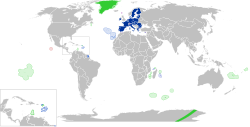
Back أقاليم ذات عضوية خاصة في الاتحاد الأوروبي Arabic Territorios especiales de la Xunión Europea AST Специални територии на Европейския съюз Bulgarian Territoris especials de la Unió Europea Catalan Oversøiske lande og territorier Danish Gebiet der Europäischen Union German Ειδικά εδάφη των κρατών μελών της Ευρωπαϊκής Ένωσης Greek Territorios especiales de la Unión Europea Spanish Euroopan unionin jäsenvaltioiden erityisalueet Finnish Territoires associés à l'Union européenne French
Special territories of members of the European Economic Area | |
|---|---|
 Location of the European Union and the special territories | |
| Largest settlements | Las Palmas, Santa Cruz de Tenerife, Ponta Delgada, Funchal, Cayenne, Saint-Denis, Mamoudzou, Fort-de-France, Les Abymes |
| Official language |
|
| Special territory | 9 Outermost Regions 13 Overseas Countries and Territories |
| Area | |
• Total | 2,733,792 km2 (1,055,523 sq mi) |
| Population | |
• Estimate | 6,114,658 |
| Currency | Euro (EUR; €; OMRs, 3 OCTs[a] and 9 special cases[b]) 5 others
|
| Date format | dd/mm/yyyy (AD) |
| This article is part of a series on |
 |
|---|
|
|
The special territories of members of the European Economic Area (EEA) are the 32 special territories of EU member states and EFTA member states which, for historical, geographical, or political reasons, enjoy special status within or outside the European Union and the European Free Trade Association.
The special territories of EU member states are categorised under three headings: nine Outermost Regions (OMR) that form part of the European Union, though they benefit from derogations from some EU laws due to their geographical remoteness from mainland Europe; thirteen Overseas Countries and Territories (OCT) that do not form part of the European Union, though they cooperate with the EU via the Overseas Countries and Territories Association; and ten special cases that form part of the European Union (with the exception of the Faroe Islands), though EU laws make ad hoc provisions. The Outermost Regions were recognised at the signing of the Maastricht Treaty in 1992,[1] and confirmed by the Treaty of Lisbon in 2007.[2]
The Treaty on the Functioning of the European Union states that both primary and secondary European Union law applies automatically to the outermost regions, with possible derogations due to the particularities of these territories. The Overseas Countries and Territories are recognised by Article 198 of the Treaty on the Functioning of the European Union which allows them to opt into EU provisions on the freedom of movement for workers and freedom of establishment, and invites them to join the Overseas Countries and Territories Association (OCTA) in order to improve cooperation with the European Union.[3] The status of an uninhabited territory, Clipperton, remains unclear since it is not explicitly mentioned in primary EU law and has a sui generis status at the national level.[4][d] Collectively, the special territories encompass a population of some 6.1 million people and a land area of about 2,733,792 square kilometres (1,055,500 sq mi). Around 80 percent of this area is represented by Greenland. The largest region by population, the Canary Islands, accounts for more than a third of the total population of the special territories. The smallest by land area is the island of Saba in the Caribbean (13 km2 or 5 sq mi). The French Southern and Antarctic Lands is the only special territory without a permanent population.
Cite error: There are <ref group=lower-alpha> tags or {{efn}} templates on this page, but the references will not show without a {{reflist|group=lower-alpha}} template or {{notelist}} template (see the help page).
- ^ Cite error: The named reference
:0was invoked but never defined (see the help page). - ^ AFP (29 October 2010). "La collectivité de Saint-Barthélémy obtient un nouveau statut européen". Ministère de l'Outre-Mer (in French). Retrieved 8 April 2011.
- ^ Cite error: The named reference
:1was invoked but never defined (see the help page). - ^ Murray, Fiona (2012). The European Union and Member State Territories: A New Legal Framework Under the EU Treaties. Springer Science & Business Media. p. 172. ISBN 978-90-6704-826-2.
© MMXXIII Rich X Search. We shall prevail. All rights reserved. Rich X Search



